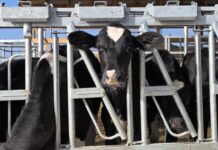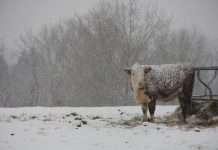Last weekend’s heat was the most challenging for bovines of all ages (and their people) so far this year.
Milking cows are usually the primary focus of heat stress abatement strategies, as they are the animals generating the most heat on the farm due to their size and their stages of lactation.
While they are not yet lactating, calves also experience heat stress and need a little extra care. For the most part, we don’t need to spend extra time or money on heat abatement for calves. The things we should be doing, if done well, will go a long way to reduce the impact of heat stress on calves.
Where should we pay a little extra attention in the summer?
Water.
Hydration is as important to a calf as it is to an athlete. A healthy calf is more than 86 percent water. A pile of corn silage has a higher dry matter content than a calf!
Calves can sweat to help cool themselves. Severely stressed calves will pant as well. We want to avoid a calf getting to the point where they would need to pant.
Water is lost through these cooling activities as well as normal respiration and urination, etc. Calves will replace some of these lost fluids through milk or milk replacer consumption. The rest must come from free choice water consumption.
From day two after birth, clean, fresh water should be available to each calf all day long.
In addition to maintaining hydration, research trials have shown over and over that starter intake and consequently growth is increased when calves have access to clean, fresh water. This seems so simple, yet it is probably the number one thing that can be improved on many farms.
Even calves receiving a gallon or more of milk or milk replacer per feeding should still have water in front of them the rest of the day.
Shade and air flow.
Housing in summer should provide shade, fresh air, and protection from rain.
Hutches should have vents to allow air flow through the hutch. If they do not have vents, make some, or prop the back of the hutch up on blocks to allow air flow.
Buildings should also have air movement to remove stale air and gas buildup. If it smells like ammonia, then there is not enough air movement.
Additional sidewall openings and fans may help in problem areas.
Back to a very simple rule. If you wouldn’t want to spend time there, don’t expect your calves to do well there.
Bedding.
Bedding can go a long way to make or break a housing situation. Clean, dry and well bedded is always key for healthy calves.
Grain.
Hot and humid summer weather adds another challenge to feeding calf starter grain. Usually this (expensive) grain has molasses as an ingredient. Keeping it fresh, clean and enticing to baby calves takes a little extra care.
Add a little water in hot summer weather and it can quickly mold or become a fly breeding ground — both nasty scenarios.
Calf feeders need to work at feeding just what calves will eat each feeding, and check buckets for grain messes that need to be cleaned out before they get nasty. Note to feeders: Look for the messes in the grain at the bottom of the bucket under what looks “OK”.
Attention to water, grain, shade, airflow, bedding, and general cleanliness in the calf area are always important. In the hot, hot days of July and August they are even more important to help calves through this additional stress in these early days of lives.












